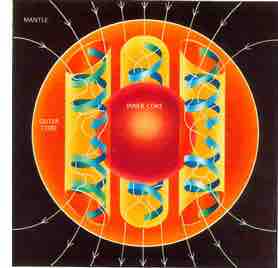Geomagnetism
The Structure of Earth's Magnetic Field
Earth is largely protected from the solar wind, a stream of energetic charged particles emanating from the sun, by its magnetic field, which deflects most of the charged particles. These particles would strip away the ozone layer, which protects Earth from harmful ultraviolet rays. The region above the ionosphere, and extending several tens of thousands of kilometers into space, is called the magnetosphere. This region protects Earth from cosmic rays that would strip away the upper atmosphere, including the ozone layer that protects our planet from harmful ultraviolet radiation. The magnetic field strength ranges from approximately 25 to 65 microteslas (0.25 to 0.65 G; by comparison, a strong refrigerator magnet has a field of about 100 G). The intensity of the field is greatest near the poles and weaker near the equator. An isodynamic chart of Earth's magnetic field, shows a minimum intensity over South America while there are maxima over northern Canada, Siberia, and the coast of Antarctica south of Australia. Near the surface of Earth, its magnetic field can be closely approximated by the field of a magnetic dipole positioned at the center of Earth and tilted at an angle of about 10° with respect to the rotational axis of Earth .
Physical Origin
Earth's magnetic field is mostly caused by electric currents in the liquid outer core, which is composed of highly conductive molten iron. A magnetic field is generated by a feedback loop: Current loops generate magnetic fields (Ampère's law); a changing magnetic field generates an electric field (Faraday's law); and the electric and magnetic fields exert a force on the charges that are flowing in currents (the Lorentz force). These effects can be combined into a partial differential equation called the magnetic induction equation:
In this equation u is the velocity of the fluid, B is the magnetic field, and eta is the magnetic diffusivity. The first term on the right hand side of the induction equation is a diffusion term. If Earth's dynamo shut off, the dipole part would disappear in a few tens of thousands of years. The motion of the molten outer iron core is sustained by convection, or motion driven by buoyancy. The temperature increases toward the center of Earth, and the higher temperature of the fluid lower down makes it buoyant. The Coriolis effect, caused by the overall planetary rotation, tends to organize the flow into rolls aligned along the north-south polar axis .

Origin of Earth's Magnetic Field
A schematic illustrating the relationship between motion of conducting fluid, organized into rolls by the Coriolis force, and the magnetic field the motion generates.
Electric currents induced in the ionosphere generate magnetic fields (ionospheric dynamo region). Such a field is always generated near where the atmosphere is closest to the sun, causing daily alterations that can deflect surface magnetic fields by as much as one degree. Typical daily variations of field strength are about 25 nanoteslas (nT), with variations over a few seconds of typically around 1 nT.
Time Variations
The geomagnetic field changes on time scales from milliseconds to millions of years. Shorter time scales mostly arise from currents in the ionosphere (ionospheric dynamo region) and magnetosphere, and some changes can be traced to geomagnetic storms or daily variations in currents. Changes over time scales of a year or more mostly reflect changes in Earth's interior, particularly the iron-rich core. Frequently, Earth's magnetosphere is hit by solar flares causing geomagnetic storms, provoking displays of aurorae. At present, the overall geomagnetic field is becoming weaker; the present strong deterioration corresponds to a 10 to 15 percent decline over the last 150 years and has accelerated in the past several years. Geomagnetic intensity has declined almost continuously from a maximum 35 percent above the modern value achieved approximately 2,000 years ago. Earth's magnetic North Pole is drifting from northern Canada toward Siberia with a presently accelerating rate—10 km per year at the beginning of the 20th century, up to 40 km per year in 2003, and since then has only accelerated.
Although Earth's field is generally well approximated by a magnetic dipole with its axis near the rotational axis, there are occasional dramatic events where the North and South geomagnetic poles trade places. These events are called geomagnetic reversals. Evidence for these events can be found worldwide in basalts, sediment cores taken from the ocean floors, and seafloor magnetic anomalies. Reversals occur at apparently random intervals ranging from less than 0.1 million years to as much as 50 million years. The most recent such event, called the Brunhes-Matuyama reversal, occurred about 780,000 years ago.